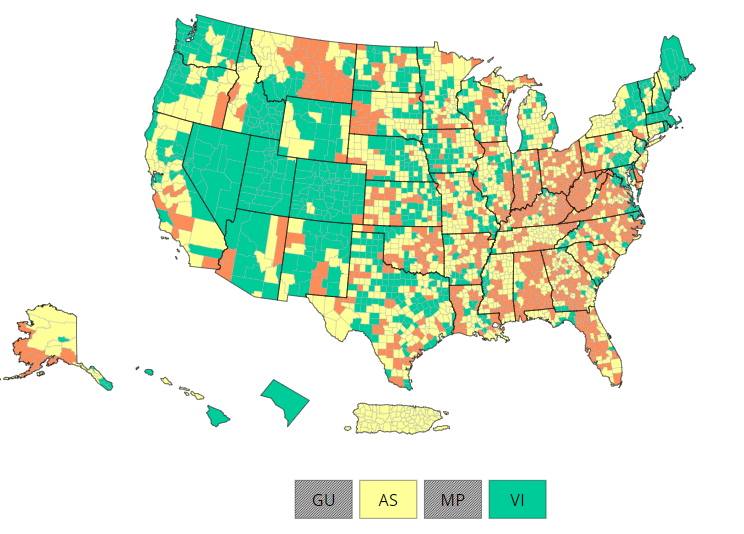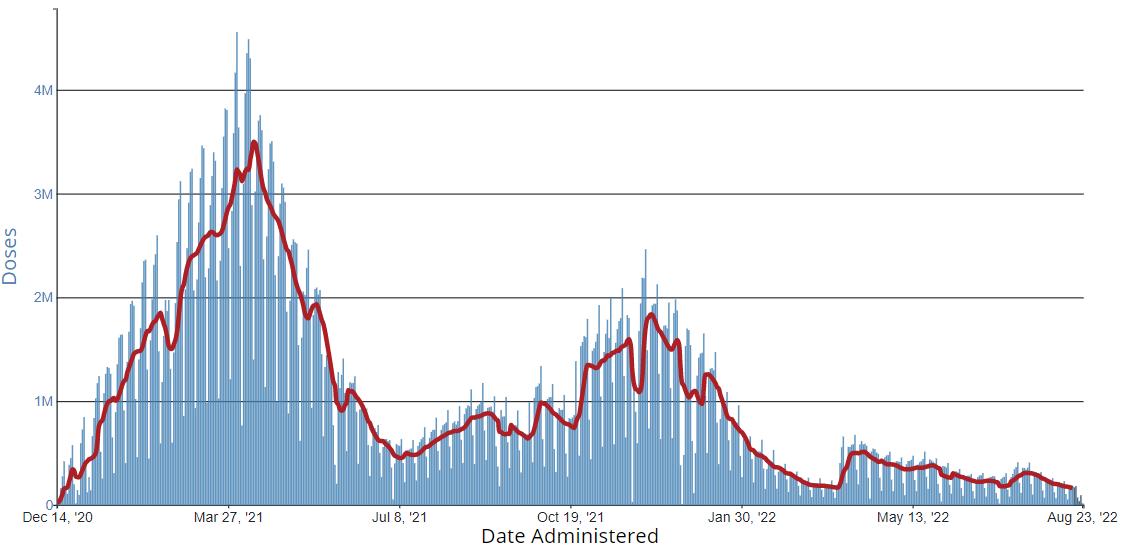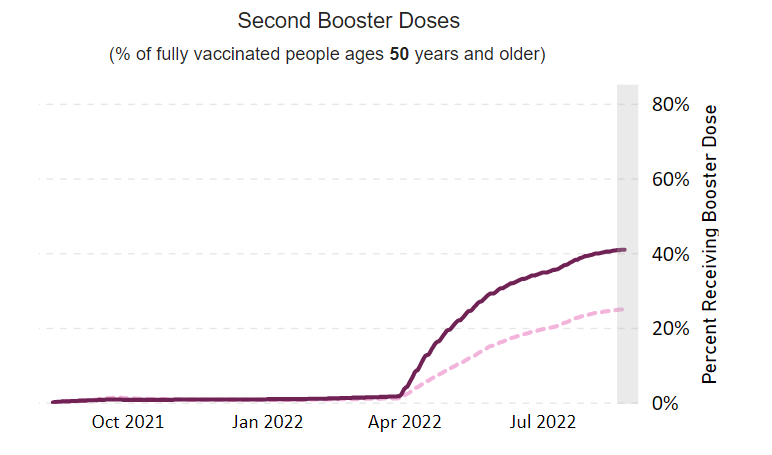Recommendations for Fully Vaccinated People
COVID-19 Homepage
Stay Up to Date with Vaccines
Interpretive Summary for August 26, 2022
Stay Up to Date with Vaccines
COVID-19 cases, hospitalizations, and deaths are leveling off from their rise over the summer. We can help prevent these numbers from increasing again by staying up to date with COVID-19 vaccinations. The good news is that 77% of adults over age 18 years have received a primary series at this point. The not-so-good news is that only half of booster-eligible adults have gotten a booster, and only 34% of adults ages 50 years and older have gotten a second booster. Vaccine effectiveness can decrease over time, but boosters restore protection, including against serious illness.
COVID Data Tracker shows that in June 2022, people ages 50 years and older with two booster doses were 14 times less likely to die from COVID-19 than unvaccinated people of the same age and three times less likely to die than vaccinated people of the same age with at least one booster. Additionally, a new CDC study conducted between March and May 2022, during the Omicron BA.2 surge, found that COVID-19 hospitalization rates increased more among adults ages 65 years and older relative to those in younger adults. Among adults who were hospitalized, 95% had one or more underlying medical condition, and rates of COVID-19-associated hospitalizations were 3.4 times higher among unvaccinated adults than adults vaccinated with at least one booster or additional dose.
These findings highlight that older adults and those with underlying medical conditions, including those who have been vaccinated with only a primary series, might still be at higher risk of getting very sick from COVID-19. Everyone who is eligible should stay up to date with their COVID-19 vaccines, including getting their boosters. People at higher risk of severe illness should take additional measures, regardless of vaccination status, including talking to a provider about treatment options if they get COVID-19.
Note to Readers: CDC will not publish the COVID Data Tracker Weekly Review on Friday, September 2, 2022. The Weekly Review will resume publication on Friday, September 9, 2022. To find all the latest COVID-19 data, visit COVID Data Tracker.
- COVID Data Tracker’s Vaccine Effectiveness tab now includes vaccine effectiveness studies published in July 2022.
- Laboratory-Confirmed COVID-19–Associated Hospitalizations Among Adults During SARS-CoV-2 Omicron BA.2 Variant Predominance — COVID-19—Associated Hospitalization Surveillance Network, 14 States, June 20, 2021–May 31, 2022
- COVID-19 Outbreaks and Mortality Among Public Transportation Workers — California, January 2020–May 2022
COVID-19 Community Levels
As of August 25, 2022, there are 951 (29.5%) counties, districts, or territories with a high COVID-19 Community Level, 1,382 (42.9%) counties with a medium Community Level, and 887 (27.6%) counties with a low Community Level. Compared with last week, this represents a moderate decrease (−4.4 percentage points) in the number of high-level counties, a marginal increase (+1.8 percentage points) in the number of medium-level counties, and a moderate increase (+2.6 percentage points) in the number of low-level counties. Overall, 48 out of 52 jurisdictions* had high- or medium-level counties this week. The District of Columbia, Massachusetts, Nevada, and Rhode Island are the only jurisdictions to have all counties at low Community Levels.
To check your COVID-19 Community Level, visit COVID Data Tracker. To learn which prevention measures are recommended based on your COVID-19 Community Level, visit COVID-19 Community Level and COVID-19 Prevention.
*Includes the 50 states, the District of Columbia, and U.S. territories.
Reported Cases
As of August 24, 2022, the current 7-day moving average of daily new cases (90,676) decreased 6.7% compared with the previous 7-day moving average (97,184). A total of 93,777,133 COVID-19 cases have been reported in the United States as of August 24, 2022
Variant Proportions
CDC Nowcast projections* for the week ending August 27, 2022, estimate that the combined national proportion of lineages designated as Omicron will continue to be 100% with the predominant Omicron lineage being BA.5, projected at 88.7% (95% PI 87.3-89.8%).
There are several lineages of Omicron and within each are multiple sublineages. The national proportion of BA.4.6 is projected to be 7.5% (95% PI 6.4-8.8%), BA.4 is projected to be 3.6% (95% PI 3.3-3.8%), and BA.2.12.1 is projected to be 0.2% (95% PI 0.2-0.3%). See COVID Data Tracker for current data.
93,777,133
Total Cases Reported
93,777,133
Total Cases Reported
90,676
Current 7-Day Average**
90,676
Current 7-Day Average**
97,184
Prior 7-Day Average
97,184
Prior 7-Day Average
-6.7%
Change in 7-Day Average since Prior Week
-6.7%
Change in 7-Day Average since Prior Week
*CDC uses Nowcast projections to predict current variant proportions circulating in the United States. The median time from specimen collection to sequence data reporting is about 3 weeks. As a result, weighted estimates for the most recent few weeks may be unstable or unavailable. Starting August 12, these projections use the most recent three weeks rather than the most recent two weeks of data. These data are now being updated on Fridays instead of Tuesdays. View Nowcast estimates on CDC’s COVID Data Tracker website on the Variant Proportions page.
**Historical cases are excluded from daily new cases and 7-day average calculations until they are incorporated into the dataset for the applicable date. Of 658,913 historical cases reported retroactively, 6,102 were reported in the current week and 11 were reported in the prior week.
Vaccinations
COVID-19 Vaccine Primary Series
As of August 24, 2022, 608.9 million vaccine doses have been administered in the United States. Overall, about 262.6 million people, or 79.1% of the total U.S. population, have received at least one dose of vaccine. About 223.9 million people, or 67.4% of the total U.S. population, have been fully vaccinated.*
608,937,334
Vaccine Doses Administered
608,937,334
Vaccine Doses Administered
262,643,277
People who received at least one dose
(79.2% of the U.S. population)
262,643,277
People who received at least one dose
(79.2% of the U.S. population)
223,914,723
People who are fully vaccinated*
(67.6% of the U.S. population)
223,914,723
People who are fully vaccinated*
(67.6% of the U.S. population)
+0.1
Percentage point increase from last week
+0.1
Percentage point increase from last week
+0.0
Percentage point change from last week
+0.0
Percentage point change from last week
*Represents the number of people who have received the second dose in a two-dose COVID-19 vaccine series (such as the Pfizer-BioNTech, Moderna, or Novavax vaccines) or one dose of the single-shot Johnson & Johnson’s Janssen vaccine.
COVID-19 Vaccine Boosters
Of those fully vaccinated, about 108.5 million people have received a booster dose,* but 49.9% of the total booster-eligible population has not yet received a booster dose. Booster dose eligibility varies by age and health condition. Learn more about who is eligible.
108,540,822
Booster Doses Administered
108,540,822
Booster Doses Administered
108,539,031
Population ≥ 5 Years of Age with a 1st booster dose*
108,539,031
Population ≥ 5 Years of Age with a 1st booster dose*
21,772,202
Population ≥ 50 Years of Age with a 2nd booster dose**
21,772,202
Population ≥ 50 Years of Age with a 2nd booster dose**
48.5%
Percentage of the Population ≥ 5 Years of Age with a 1st booster dose
48.5%
Percentage of the Population ≥ 5 Years of Age with a 1st booster dose
33.7%
Percentage of the Population ≥ 50 Years of Age with a 2nd booster dose
33.7%
Percentage of the Population ≥ 50 Years of Age with a 2nd booster dose
+0.1
Percentage point increase from last week
+0.1
Percentage point increase from last week
+0.5
Percentage point increase from last week
+0.5
Percentage point increase from last week
*Represents the number of people who are fully vaccinated and have received another dose of COVID-19 vaccine since August 13, 2021. This includes people who received their first additional dose or booster dose.
**Represents the number of people who are fully vaccinated and have received two subsequent doses of COVID-19 vaccine since August 13, 2021. This includes people who received two booster doses and people who received one additional dose and one booster dose.
Hospitalizations
New Hospital Admissions
The current 7-day daily average for August 17–23, 2022, was 5,314. This is a 6.6% decrease from the prior 7-day average (5,687) from August 10–16, 2022.
5,198,924
Total New Admissions
5,198,924
Total New Admissions
5,314
Current 7-Day Average
5,314
Current 7-Day Average
5,687
Prior 7-Day Average
5,687
Prior 7-Day Average
-6.6%
Change in 7-Day Average
-6.6%
Change in 7-Day Average
The start of consistent reporting of hospital admissions data was August 1, 2020.
Daily Trends in Number of New COVID-19 Hospital Admissions in the United States

New admissions are pulled from a 10 am EDT snapshot of the HHS Unified Hospital Data – Analytic Dataset. Due to potential reporting delays, data from the most recent 7 days, as noted in the figure above with the grey bar, should be interpreted with caution. Small shifts in historic data may also occur due to changes in the Centers for Medicare & Medicaid Services (CMS) Provider of Services file, which is used to identify the cohort of included hospitals.
COVID-NET: Hospitalization Rates by Vaccination Status among Adults Ages ≥65 Years
CDC’s Coronavirus Disease 2019-Associated Hospitalization Surveillance Network (COVID-NET) shows that overall rates of COVID-19-associated hospitalizations have increased since the week ending April 2, 2022. Notably, rates among adults ages 65 years and older have seen a sharp increase, from 6.4 per 100,000 population on April 2, to 31.5 per 100,000 population on August 6. Since April 9, rates of COVID-19-associated hospitalizations among adults ages 65 years and older have remained more than 3 times as high as rates in adults ages 50–64 years.
This new report using COVID-NET data gives more information on COVID-19-associated hospitalizations among adults ages 65 years and older during the Omicron BA.2 period.
Hospitalization Rates by Vaccination Status among Adults Ages ≥65 Years
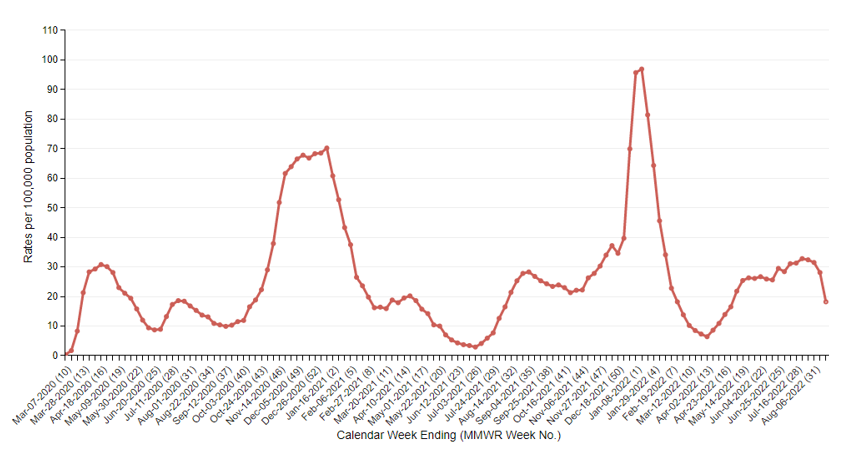
The Coronavirus Disease 2019 (COVID-19)-Associated Hospitalization Surveillance Network (COVID-NET) is an additional source for hospitalization data collected through a network of more than 250 acute-care hospitals in 14 states (representing ~10% of the U.S. population). Detailed data on patient demographics, including race/ethnicity, underlying medical conditions, medical interventions, and clinical outcomes, are collected using a standardized case reporting form.
Deaths
The current 7-day moving average of new deaths (390) has decreased 11.6% compared with the previous 7-day moving average (441). As of August 24, 2022, a total of 1,037,381 COVID-19 deaths have been reported in the United States.
1,037,381
Total Deaths Reported
1,037,381
Total Deaths Reported
390
Current 7-Day Average*
390
Current 7-Day Average*
441
Prior 7-Day Average
441
Prior 7-Day Average
-11.6%
Change in 7-Day Average Since Prior Week
-11.6%
Change in 7-Day Average Since Prior Week
*Historical deaths are excluded from the daily new deaths and 7-day average calculations until they are incorporated into the dataset by their applicable date. Of 21,756 historical deaths reported retroactively, none were reported in the current week; and none were reported in the prior week.
Daily Trends in Number of COVID-19 Deaths in the United States Reported to CDC

7-Day moving average
 More Death Data
More Death DataTesting
The percentage of COVID-19 NAATs (nucleic acid amplification tests)* that are positive is decreasing in comparison to the previous week. The 7-day average of percent positivity from NAATs is now 14.6%. The 7-day average number of tests reported for August 12–18, 2022, was 504,944, down 5.1% from 532,031 for the prior 7 days.
945,040,506
Total Tests Reported
945,040,506
Total Tests Reported
504,944
7-Day Average Tests Reported
504,944
7-Day Average Tests Reported
14.6%
7-Day Average % Positivity
14.6%
7-Day Average % Positivity
15.4%
Previous 7-Day Average % Positivity
15.4%
Previous 7-Day Average % Positivity
-0.86
Percentage point change in 7-Day Average % Positivity since Prior Week
-0.86
Percentage point change in 7-Day Average % Positivity since Prior Week
*Test for SARS-CoV-2, the virus that causes COVID-19
Wastewater Surveillance
COVID Data Tracker’s Wastewater Surveillance tab tracks levels, changes, and detections of SARS-CoV-2* viral RNA in wastewater at over 1,000 testing sites across the country.
Currently, most of the country is reporting moderate to high SARS-CoV-2 levels in wastewater. About 39% of sites reporting wastewater data are currently seeing some of the highest levels for those sites since December 1, 2021. About half of sites are experiencing a decrease in SARS-CoV-2 levels, and about 40% are reporting an increase. It’s important to note that even a small increase when levels are low can appear like a dramatic increase in the percent change.
For more information on how to use wastewater data, visit CDC’s website.
*The virus that causes COVID-19
SARS-CoV-2 Levels in Wastewater by Site
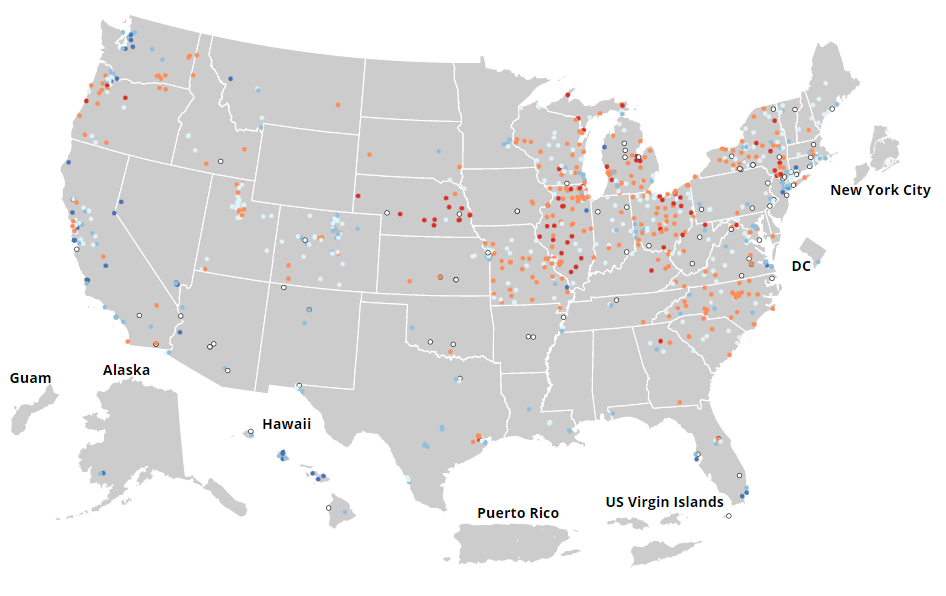

0% means levels are the lowest they have been at the site; 100% means levels are the highest they have been at the site.


